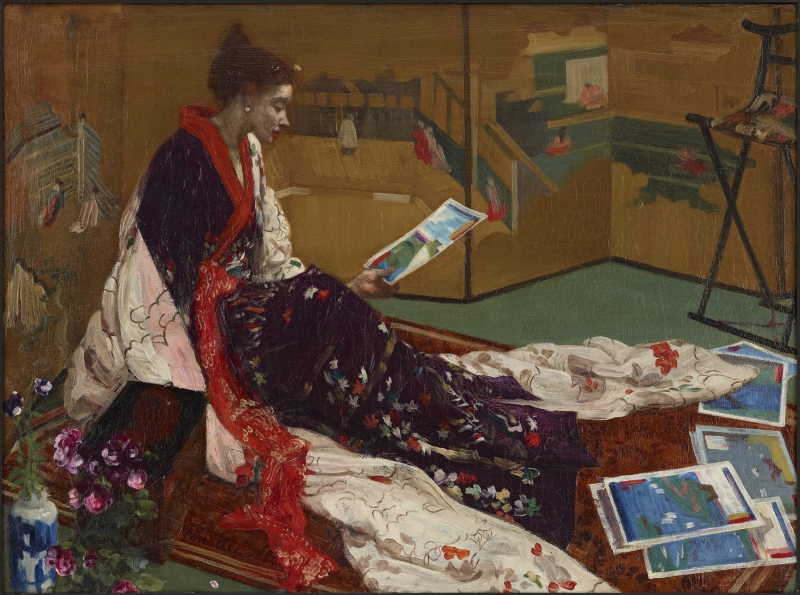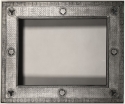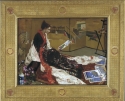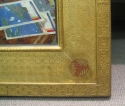Home > Catalogue > People > Valentine Cameron Prinsep (related works) > Catalogue entry
Technique
It is on a thick wooden panel. It was painted carefully, richly coloured, with signs of alterations to the outlines of the carpet, prints, and clothes of the model. She may originally have turned more away from the viewer. Her knees and the curve of drapery were higher on the canvas. There was originally another woodcut on the floor at right, above those shown. At the lower right corner it is clear that the print was painted over the edge of the carpet.
There is some impasto on the draperies around the figure, and in the flowers at left. A wide variety of brushstrokes was used, from small dots for details like her earring and hair ornament, criss-crossing delicate strokes building up the modelling of the face, and broad, slashing strokes and blobs on the robe and embroidery. The background and floor are smoothly painted, setting off the vigorous brushwork in the foreground.
The woodcuts are surprisingly broadly painted, with a square ended brush applying blocks of colour, rather than replicating the detail of the images. 1 Anna Gruetzner Robins comments 'There is much in this picture to hold the viewer's attention, not least the vibrant colour effects in the prints, reduced to colour lozenges of red, yellow and blue that punctuate the landscapes of each print.' 2 It is apparent that it is the colour that influenced Whistler at this time: it was some years before the expressive shape of brushstrokes in Asian art had a major impact on his work. 3
Conservation History

Caprice in Purple and Gold: The Golden Screen, photo, Goupil Album, 1892, Glasgow University Library, Whistler PH5/6/8
Several repairs were carried out in the Freer Gallery of Art. A split in the panel was glued in 1921 and the panel was cradled in the following year. Cracks were infilled and the painting resurfaced in 1931. It was cleaned and resurfaced in 1935 and 1951. Heavy discoloured varnish and retouching was removed by Ben Johnson in 1965, and it was partially inpainted and cleaned before being varnished.
Frame
- 1864/1865: cassetta frame, raised flat outer edge with applied cross-hatch/ lacquer box pattern of composition; inner frieze of incised whorls and six incised roundels of Japanese mon at the corners and midpoints; incised astragal site edge. Probably English-made.
- 1892: possibly reframed by Frederick Henry Grau (1859-1892) for the Goupil Gallery exhibition.
- After 1975: reframed in its original Whistler frame with incised decoration. [FD] 30 x 36 ¾" (76.2 x 93.3 cm), [MW] 5 ¼" (13.3 cm). 4
The provenance for the frame currently now on Caprice in Purple and Gold: The Golden Screen [YMSM 060] is unknown, as it apparently entered the Freer Gallery of Art in 1919 on a different painting, Portrait Sketch of a Lady [YMSM 184], which is of a much later date. Andrew McLaren Young (1913-1975) attributed the present frame to this painting on grounds of its size, and its similarity to the frame designed for Purple and Rose: The Lange Leizen of the Six Marks [YMSM 047], which was painted in the same year.
However, while the current frame is extremely similar in style and design to Whistler’s 1864 frames, as on La Princesse du pays de la porcelaine [YMSM 050] and Purple and Rose: The Lange Leizen of the Six Marks [YMSM 047], and possibly Symphony in White, No. 2: The Little White Girl [YMSM 052] and Variations in Flesh Colour and Green: The Balcony [YMSM 056]), the construction differs significantly.
The frame on Purple and Rose: The Lange Leizen of the Six Marks is made of solid wood pieces, while the frames on both La Princesse du pays de la porcelaine and Purple and Rose: The Lange Leizen of the Six Marks consist of several pieces of moulding joined together with wood corner blocks. The varying construction may suggest that it was made by a frame-maker other than Joseph Green. It could also suggest that it was not made in 1864, but at a later time. Furthermore, it could even indicate the work of an American framer, who may have had only a picture of the other 1864 frames to work from. While the frame looks as if it is original to the piece, it is difficult to know for certain.
The original frame, whether or not it is the current frame, may have been on Caprice in Purple and Gold: The Golden Screen as early as 1865, and that frame may have been removed in 1892 when most of Whistler's works were reframed by Frederick Henry Grau (1859-1892). During preparations for the Goupil Gallery exhibition the majority of Whistler's works were reframed in the simpler Grau frame (gilded, reeded and quite broad) and it is possible that this painting was reframed at that time. This is not certain because Whistler himself was vague on the subject: he queried whether it had been reframed and if the owner had paid for that. 5 However, it is possible that a Grau frame was on the work when it was purchased by Charles Lang Freer in 1904.
Notes:
1: See MacDonald, Margaret F., Joanna Dunn, and Joyce H. Townsend, 'Painting Joanna Hiffernan', in Margaret F. MacDonald (ed.), The Woman in White: Joanna Hiffernan and James McNeill Whistler, New Haven and Washington, 2020, pp. 33-45.
2: Robins 2007 [more] , pp. 26-27.
3: See MacDonald, Margaret F., 'Joanna Hiffernan and James Whistler: an Artistic Partnership' in Margaret F. MacDonald (ed.), The Woman in White: Joanna Hiffernan and James McNeill Whistler, New Haven and Washington, 2020, pp. 15-31.
4: Dr Sarah L. Parkerson Day, Report on frames, 2017; see also Parkerson 2007 [more] .
Last updated: 11th October 2021 by Margaret









